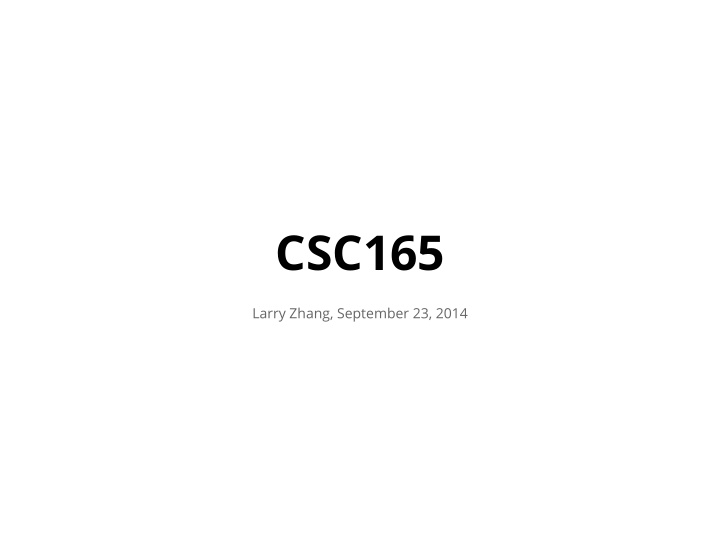



CSC165 Larry Zhang, September 23, 2014
Tutorial classrooms T0101, Tuesday 9:10am~10:30am: BA3102 A-F (Jason/Jason) BA3116 G-L (Eleni/Eleni) BA2185 M-T (Madina/Madina) BA2175 V-Z (Siamak/Siamak) T0201: Monday 7:10~8:30pm BA2175* A-D (Ekaterina/Ekaterina) BA1240* E-Li (Gal/Gal) BA2185* Liang-S (Yana/Adam) BA3116 T-Z (Christina/Nadira) T5101: Thursday 7:10~8:30pm BA3116 A-F (Christine/Christine) BA2135 G-Li (Elias/Elias) BA1200* Lin-U (Yiyan/Yiyan) GB244* V-Z (Natalie/Natalie)
Today’s agenda ➔ More elements of the language of Math ◆ Conjunctions ◆ Disjunctions ◆ Negations ◆ Truth tables ◆ Manipulation laws
Lecture 3.1 Conjunctions, Disjunctions Course Notes: Chapter 2
Conjunction (AND, ∧ ) noun “the action or an instance of two or more events or things occurring at the same point in time or space.” Synonyms : co-occurrence, coexistence, simultaneity.
Conjunction (AND, ∧ ) Combine two statements by claiming they are both true. R(x) : Car x is red. F(x) : Car x is a Ferrari. R(x) and F(x) : Car x is red and a Ferrari. R(x) ∧ F(x)
Which ones are R(x) ∧ F(x)
Conjunction (AND, ∧ ) As sets (instead of predicates) : R : the set of red cars F : the set of Ferrari cars Intersection
What are R , F , R ∩ F
➔ Using predicates: R(x) ∧ F(x) ➔ Using sets: R ∩ F
Be careful with English “and” There is a pen, and a telephone. O : the set of all objects P(x) : x is a pen. T(x) : x is a telephone.
Be careful, even in math The solutions are x < 20 and x > 10 . The solutions are x > 20 and x < 10 .
Disjunction
Disjunction (OR, ∨ ) Combine two statements by claiming that at least one of them is true . R(x) : Car x is red. F(x) : Car x is a Ferrari. R(x) or F(x) : Car x is red or a Ferrari. R(x) ∨ F(x)
Which ones are R(x) ∨ F(x)
Disjunction (OR, ∨ ) As sets (instead of predicates) : R : the set of red cars F : the set of Ferrari cars Union
What are R , F , R ∪ F
➔ Using predicates: R(x) ∨ F(x) ➔ Using sets: R ∪ F
Be careful with English “or” Either we play the game my way, or I’m taking my ball and going home.
Summary ➔ Conjunction: AND, ∧ , ∩ ➔ Disjunction: OR, ∨ , ∪
Lecture 3.2 Negations Course Notes: Chapter 2
Negation (NOT, ¬) C : set of all cars All red cars are Ferrari. negation
Negation (NOT, ¬) Not all red cars are Ferrari. equivalent
Exercise: Negate-it!
Exercise: Negate-it! Rule : the negation sign should apply to the smallest possible part of the expression. NO GOOD! GOOD!
Exercise: Negate-it! All cars are red. NEG
Exercise: Negate-it! There exists a car that is red. NEG
Exercise: Negate-it! Every red car is a Ferrari. NEG
Exercise: Negate-it! There exists a car that is red and Ferrari. NEG
Some tips ➔ The negation of a universal quantification is an existential quantification (“ not all... ” means “ there is one that is not... ”). ➔ The negation of a existential quantification is an universal quantification (“ there does not exist... ” means “ all...are not... ”) ➔ Push the negation sign inside layer by layer ( like peeling an onion ).
Exercise: Negate-it! NEG
Scope
Parentheses are important! NO GOOD!
Scope inside parentheses
Lecture 3.3 Truth tables Course Notes: Chapter 2
It’s about visualization... Q P Venn diagram works pretty well… … for TWO predicates.
What if we have more predicates?
Truth table with 2 predicates Enumerate outcomes of all possible combinations of values of P and Q . How many rows are there?
Truth table with 3 predicates How many rows are there?
Unsatisfiable Satisfiable P Q P ∧ Q P ∧ ¬ P T T T F F T F F
P Q ¬ ( P ∨ Q ) ¬ P ∧ ¬ Q T T T F F T F F
De Morgan’s Law
Other laws Commutative laws
Other laws Associative laws
Other laws Distributive laws
Other laws Identity laws
Other laws Idempotent laws
Other laws For even more laws, read Chapter 2.17 of Course Notes.
About these laws... ➔ Similar to those for arithmetics. ➔ Only use when you are sure. ➔ Understand them , be able to derive them, rather than memorizing them.
Summary for today ➔ Conjunctions ➔ Disjunctions ➔ Negations ➔ Truth tables ➔ Manipulation laws ➔ We are almost done with learning the language of math.
Recommend
More recommend